- Established 1982 -HOME: www.hiltonpond.org
THIS WEEK at HILTON POND Subscribe for free to our award-winning nature newsletter (Back to Preceding Week; on to Next Week) |
All text, maps, charts & photos © Hilton Pond Center PURPLE FINCHES: February 2019 was without doubt one of the wettest months we can remember. Although the month started dry, from the 10th through 28th our Hilton Pond Center digital rain gauge recorded 5.51" of precipitation. That wasn't a HUGE amount, but with rainfall occurring almost every day during the last half of the month things seemed awfully wet and dreary. Our trails were totally saturated and a sloppy, soggy mess, with the pond itself full to overflowing for almost that whole period. There was just no way we could deploy bird nets during near-constant days of heavy mist, drizzle, spit-rain, and numerous cat-and-dog downpours.
The current winter of 2018-19 was predicted to be a "Finch Winter" because a poor tree seed crop in Canada was expected to drive hungry breeding birds of the boreal forest far to the south. At Hilton Pond Center we were ready last fall for a bumper crop of winter finches that despite our enthusiasm showed up in much lower numbers than expected. (NOTE: We also hoped to see Evening Grosbeaks this winter after a 25-year absence from the Center, but this species may be gone forever this far south. The closest eBird report we could find for EVGR was on 30 December 2018--a solitary female at a feeder in Granite Falls NC, just above Hickory and 60 miles to our north. Boreal-breeding Red-breasted Nuthatches that often appear during "finch winters" likewise were absent from Hilton Pond this year. We haven't seen or banded one locally since 2013.)
All text, maps, charts & photos © Hilton Pond Center When January 2019 arrived, things picked up a little at the Center's feeding stations--well, except for Pine Siskins; for that sometimes abundant species we've had just ONE sighting and NO bandings during the current calendar year. House Finches also have been few and far between, with only 22 banded in 2018. (Male HOFI, above; note the decurved upper mandible.) Thankfully, American Goldfinches came on strong (208 banded through February), and Purple Finches were even more plentiful with 297 receiving numbered aluminum bands during the first two months of the year.
All text, maps, charts & photos © Hilton Pond Center We indeed had several busy banding sessions with Purple Finches, although during the first half of January we were catching only a couple or so per day. (Adult male PUFI, above; note the straight upper mandible). Things started to change on 19 January when we caught seven PUFI, followed by 25 on the 24th, 16 on the 25th, and 19 on the 29th. We were trapping so many Purple Finches in January that eBird red-flagged our numbers as "unusually high" for a location in the South Carolina Piedmont. Despite eBird's doubts, Purple Finches really popped in early and mid-February when we banded ten on 11th, 27 on the 13th, a season-high 33 on the 14th (eBird REALLY flipped on THIS number!), 11 on the 15th, 28 on the 17th, 15 on the 18th, 19 on the 20th, and 11 on the 24th. On 25 February we captured just three new Purple Finches and then--as if by magic--they were all GONE, with NONE captured or seen on the 26th through the 28th of the month! It wasn't the Purple Finches' departure that was so surprising, it was that they seemingly did it all together and so suddenly. "Here today, gone tomorrow," for sure.
All text, maps, charts & photos © Hilton Pond Center This sudden disappearance of all our Purple Finches by 26 February--preceded a few days earlier by similar departure of the last of our American Goldfinches--was curious, and somewhat disappointing. (See our deserted and forlorn platform feeder, above.) So what was going on? Could "Joe Down the Road" have just opened a new feeding station that enticed away our winter finches? Had some change in weather here (or elsewhere) prompted a sudden bailout from Hilton Pond? Did the calendar and corresponding longer day-length trigger a migratory urge? Did the finches finally get tired of being harassed daily by a couple of bird-eating accipiters (or one of our much larger, ever-hungry, resident Red-shouldered Hawks)? Or was there some other factor we hadn't considered? To be honest, we don't have an answer. Nature is so complex it is often difficult to deduce cause-and-effect relationships. Heck, we don't even know if we're asking the right questions! Regardless, of one thing we are certain: Our Purple Finches and American Goldfinches did NOT depart Hilton Pond Center for lack of sunflower seeds. We've been faithfully filling our giant-sized tube feeders almost daily throughout the winter, and thanks to the Center's generous supporters we can buy enough seeds to guarantee those feeders are NEVER empty! All text, maps, charts & photos © Hilton Pond Center (Click on chart above for a larger version in a new browser window) No matter what brought Purple Finches to the Center this winter or why they left en masse, so far in 2019 we've banded 297 PUFI (see chart above). We didn't quite make it to 300, but this is still our twelfth-best total in 38 years, with a chance we'll get more Purple Finches this coming autumn. During the 13-28 February period we also caught four "old" PUFI--including one banded locally in March 2015 as an after-second-year male; he's now in at least his seventh year! (All recent returns/recaptures are listed in our banding tallies at the bottom of this Web page.) Looking at the chart above we see since 2011 there has been an up-and-down pattern of local PUFI abundance--a sequence that also occurred 1998 through 2008. It's possible these are statistical artifacts, but because our winter finch-trapping protocol varies very little year-to-year we suspect there is a pattern of significance. (Does the pattern suggest wild seed crops in Canada are also more or less abundant every other year? Again, it's hard to say what might cause such an alternation of numbers.)
All text, maps, charts & photos © Hilton Pond Center Our best year ever for banding Purple Finches (adult male, above) was 2004 with 950, but--on average--local numbers for this species seem to be declining (see dotted red trend line on the chart). This is cause for more speculation: Are there fewer PUFI in the world than there used to be? Has something changed at or around Hilton Pond Center during the past 38 years that makes it a less attractive wintering spot? Since Purple Finches are not "obligate migrants" that HAVE TO migrate every year like Wood Warblers, are they less likely to fly south because well-stocked feeders up north are now meeting their winter needs? Or does "global warming" have something to do with fewer PUFI departing a formerly chillier northland to fly to the historically warmer South? Once again, we don't have the answer(s), but at least our long-term banding work allows us to ask pertinent questions--questions that researchers in other related fields may be able to answer. In science, it's always okay to say "I don't know," so long as one also says "I think I'll try to find out." All text, maps, charts & photos © Hilton Pond Center PURPLE FINCH CLOSE-UP Having described our January-February 2019 finch-banding efforts and subsequently peppered our faithful readers with all those seemingly unanswerable questions, we thought it might be good to wind down with several photos of Purple Finches. Some of these were taken at Hilton Pond Center in previous years, but we include them here to explain a few things about ageing and sexing this relatively common feeder bird. To start, please do NOT confuse Purple Finches with House Finches. They're really quite easy to tell apart, as described by our two comparative charts and photos below. (Pardon us if we start to seem a little repetitious; we're just trying to get some points across to help you in your birding identifications.)
All text, maps, charts & photos © Hilton Pond Center Only "adult" male Purple Finches (above) are red; it takes two years for males to acquire their full color. (Conversely, House Finch male fledglings turn red late in their first autumn.) Note the PUFI's whitish-raspberry superciliary line (above the eye; absent in House Finch), and the straight ridge of his upper mandible (not decurved as in a House Finch).
All text, maps, charts & photos © Hilton Pond Center Brown Purple Finches (above and below) can be adult females, immature females, or immature males, so it's not feasible to determine sex of a brown PUFI at your feeder. Note the white superciliary line (absent in House Finch).
All text, maps, charts & photos © Hilton Pond Center Again,it would be improper--and possibly incorrect--to say a Purple Finch at your feeder that looks like the one above is a "female." Actually, it MIGHT be a female of any age, but it could just as well be an "immature male." Remember, male PUFI take two years to become raspberry-colored.
All text, maps, charts & photos © Hilton Pond Center Occasionally you may see a Purple Finch with pinkish wash and/or a red rump, as shown above and below. Do not be misled into thinking these have to be young male PUFI because . . .
All text, maps, charts & photos © Hilton Pond Center . . . sometimes "old" female Purple Finches acquire this reddish tint. In fact, the bird in the photo just above is a 5th-year female, while the one above that is a second-year male we were able to sex upon recapture as a fully red PUFI a few years later at Hilton Pond Center. Pink is NOT a dependable sign of age in Purple Finches.
All text, maps, charts & photos © Hilton Pond Center The same cautions hold true for the occasional Purple Finch that has a gold wash and/or a bright gold rump. It's possible the bird above is a young male that had gotten a head start on his adult plumage but laid down yellow pigment instead of red.
All text, maps, charts & photos © Hilton Pond Center That said, it's just as possible that gold bird (mug shot just above) is an older female whose pigment mechanism was a bit aberrational, causing her to lay down yellow or gold instead of red.
All text, maps, charts & photos © Hilton Pond Center If you have really, really good eyes, you can sometimes tell when a brown Purple Finch at your feeder is a youngster because its rectrices (tail feathers) are strongly acute (pointed), as at upper left. Older birds tend to have much-less-pointy feathers that may be rounded or a little truncate (squared off), as above right. This characteristic is difficult enough to evaluate when we have a Purple Finch in-hand--especially if feathers are wet--so don't feel frustrated when you can't see it on a feeder bird.
All text, maps, charts & photos © Hilton Pond Center One sure sign of a young bird is when we find "fault bars" in a Purple Finch's rectrices (above). These defects form when a nestling PUFI is under stress, perhaps on a day when its parents fail to provide enough food and/or when weather is particularly cold and wet. In nestlings, all tail feathers grow in simultaneously, so the fault bars will be at the same place on all or most of the rectrices, as shown. Fault bars can occur in adults, too, but because new adult tail feathers grow in as corresponding pairs--first the central pair, then the next-most-central, etc.--fault bars will be in different places (or absent) on adjoining feathers. So there you have it. Even though our Purple Finch population was "here today, gone tomorrow," we hope the information we offer above will stick with you--at least until next time you see some of these raspberry-colored (or brown) non-obligate migrants gorging on sunflowers seeds outside your kitchen window. All text, maps, charts & photos © Hilton Pond Center
Checks also can be sent to Hilton Pond Center at: All contributions are tax-deductible on your Don't forget to scroll down for Nature Notes & Photos, |
||||||||||
|---|---|---|---|---|---|---|---|---|---|---|
|
"This Week at Hilton Pond" is written and photographed by Bill Hilton Jr., executive director of Hilton Pond Center for Piedmont Natural History
|
|
|
Please refer "This Week at Hilton Pond" to others by clicking on this button: |
|

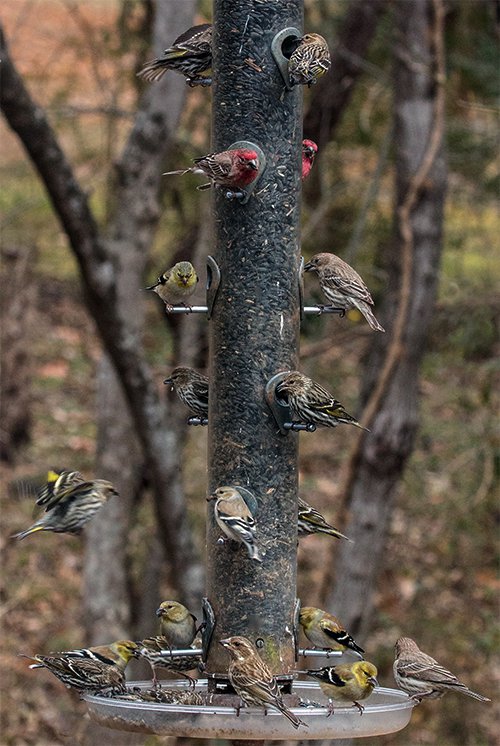
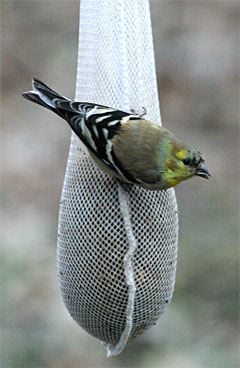 Most of the time in February it was unwise to operate
Most of the time in February it was unwise to operate  From October through December we tallied only 42 American Goldfinches
From October through December we tallied only 42 American Goldfinches 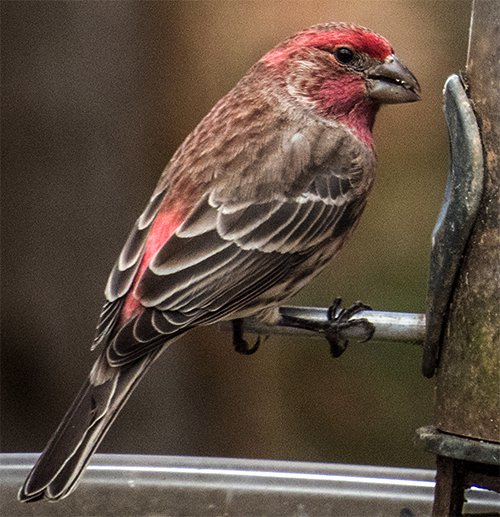
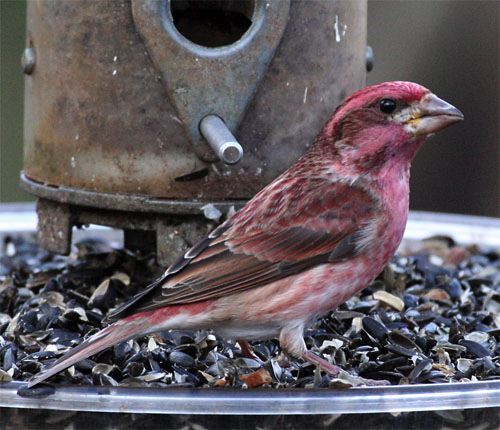

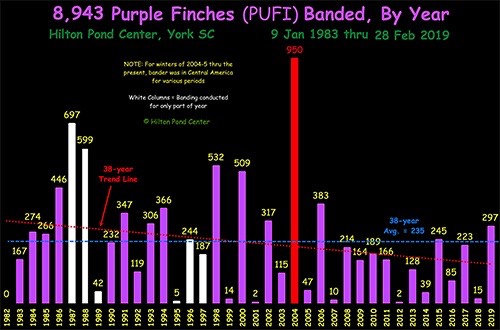
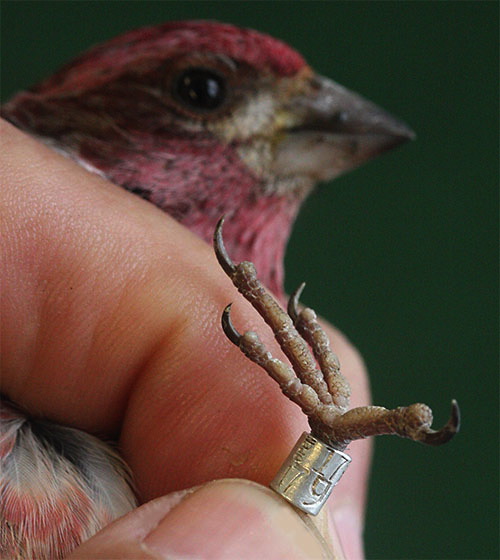

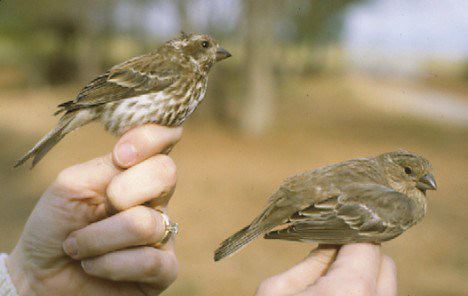
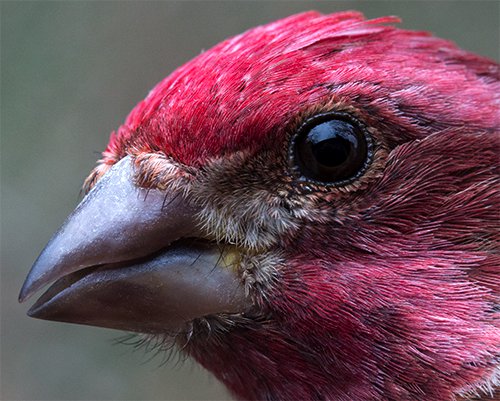

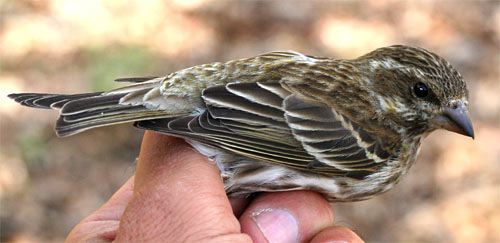

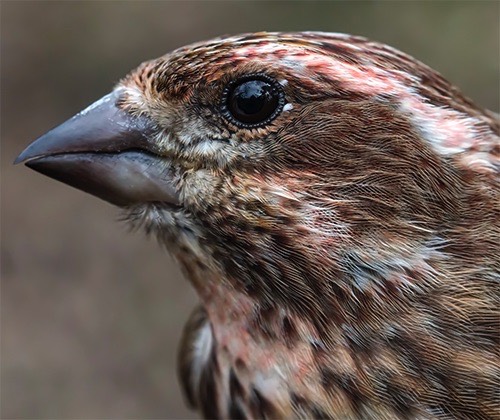
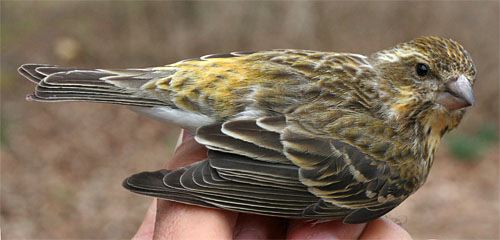
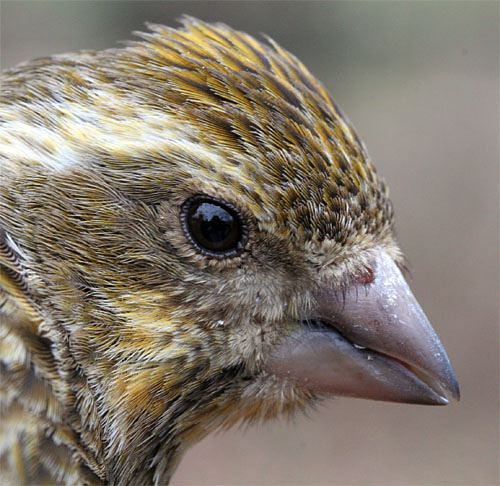
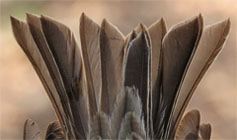 .
. 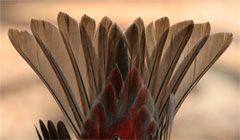
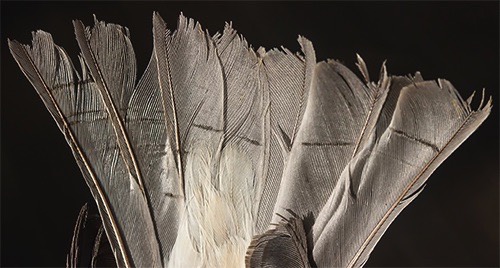










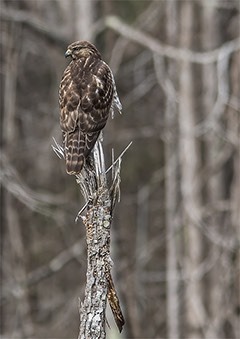
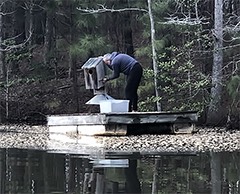
 Oct 15 to Mar 15:
Oct 15 to Mar 15: